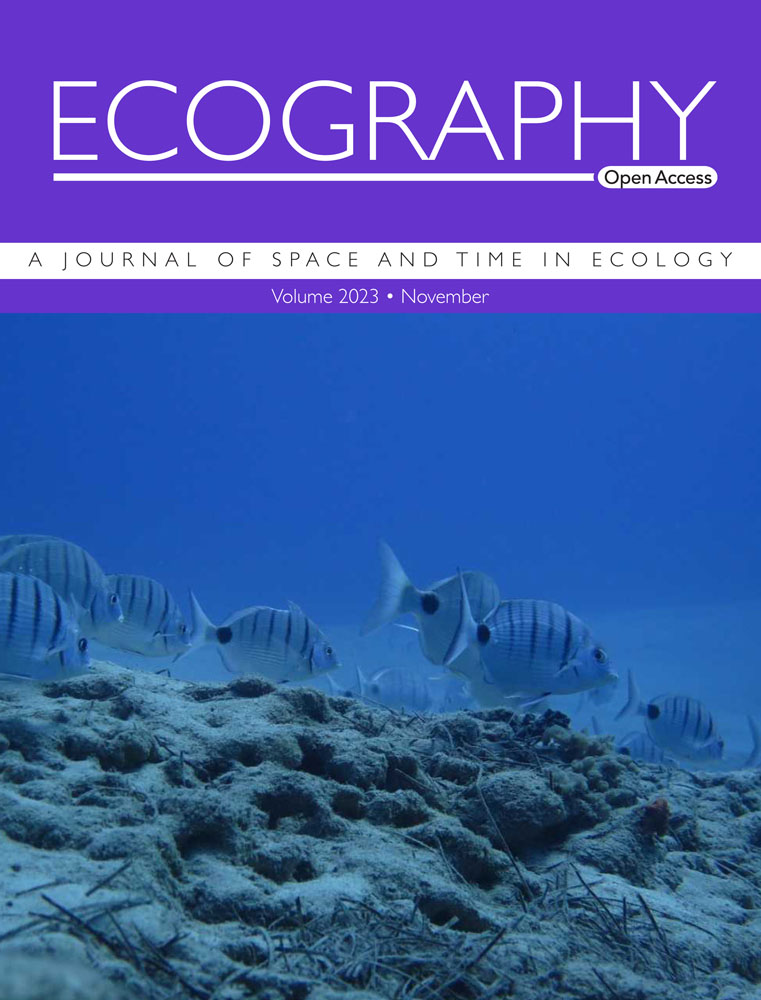降雨增加了物种-区域关系的一致性和强度
IF 4.7
1区 环境科学与生态学
Q1 BIODIVERSITY CONSERVATION
引用次数: 0
摘要
物种丰富度与面积的正相关关系被认为是生态学中为数不多的规律之一。因此,偏离可预测的物种-面积尺度,在物种-面积曲线中表现为高残留方差,通常被解释为异常行为。小岛屿系统通常不符合物种-面积关系,但其物种-面积曲线的高随机性经常被视为无法解释的噪音或归因于特殊的灭绝率。在这里,我们引入了一个统计框架,该框架将物种-区域关系的随机性程度作为一个明确的、可解释的模型参数。利用环礁岛的全球岛屿植物数据集(19个环礁岛中的378个岛屿)——小岛屿动态的典型例子——我们表明,物种-面积曲线的剩余方差程度可以被捕获、建模并与环境条件联系起来。我们的异方差建模方法表明,物种-区域关系的表观随机性不是随机的,而是可以通过环境驱动因素预测的。具体而言,我们发现降雨量增加减少了物种-面积曲线周围的剩余方差,表明资源可用性是使物种-面积尺度符合的关键因素。气旋扰动频率不驱动随机性,挑战了扰动机制驱动小岛屿物种-面积尺度随机性的主流观点。通过将剩余方差作为物种-面积关系的明确模型参数,而不是无法解释的噪声,我们的方法为使生物群落符合物种-面积尺度的条件提供了新的见解。将物种-区域研究的重点转移到剩余方差作为一种可解释的模型参数,以捕捉物种-区域尺度的符合程度,为研究物种-区域尺度的先决条件提供了新的视角。这有助于将小岛屿系统的明显异常、随机性质与线性物种-面积尺度的一般规律统一起来。本文章由计算机程序翻译,如有差异,请以英文原文为准。
Rainfall increases conformity and strength of species–area relationships
The positive relationship between species richness and area is regarded as one of the few laws in ecology. Therefore, deviations from predictable species–area scaling, evident as high residual variance in species–area curves, are often interpreted as anomalous behaviour. Small‐island systems often do not conform to species–area relationships, yet the high stochasticity in their species–area curves is frequently treated as unexplainable noise or attributed to idiosyncratic extinction rates. Here, we introduce a statistical framework that incorporates the degree of stochasticity in species–area relationships as an explicit, interpretable model parameter. Using a global island plant dataset for atolls (378 islands across 19 atolls) – prototypical examples for small‐island dynamics – we show that the degree of residual variance in species–area curves can be captured, modelled, and linked to environmental conditions. Our heteroscedastic modelling approach demonstrates that apparent stochasticity in species–area relationships is not random but predictable through environmental drivers. Specifically, we found that increased rainfall reduces the residual variance around the species–area curve, indicating that resource availability is a critical factor enabling conformity to species–area scaling. Cyclone disturbance frequency did not drive stochasticity, challenging the prevailing view that disturbance regimes drive the stochasticity in species–area scaling on small islands. By treating residual variance as an explicit model parameter in species–area relationships rather than unexplainable noise, our approach provides new insights into the conditions enabling biological communities to conform to species–area scaling. Shifting the focus in species–area studies on the residual variance as an interpretable model parameter that captures the degree of conformity to species–area scaling offers novel perspectives into the environmental factors prerequisite for species–area scaling. This contributes to unifying the apparent anomalous, stochastic nature of small‐island systems with the general law of linear species–area scaling.
求助全文
通过发布文献求助,成功后即可免费获取论文全文。
去求助
来源期刊

Ecography
环境科学-生态学
CiteScore
11.60
自引率
3.40%
发文量
122
审稿时长
8-16 weeks
期刊介绍:
ECOGRAPHY publishes exciting, novel, and important articles that significantly advance understanding of ecological or biodiversity patterns in space or time. Papers focusing on conservation or restoration are welcomed, provided they are anchored in ecological theory and convey a general message that goes beyond a single case study. We encourage papers that seek advancing the field through the development and testing of theory or methodology, or by proposing new tools for analysis or interpretation of ecological phenomena. Manuscripts are expected to address general principles in ecology, though they may do so using a specific model system if they adequately frame the problem relative to a generalized ecological question or problem.
Purely descriptive papers are considered only if breaking new ground and/or describing patterns seldom explored. Studies focused on a single species or single location are generally discouraged unless they make a significant contribution to advancing general theory or understanding of biodiversity patterns and processes. Manuscripts merely confirming or marginally extending results of previous work are unlikely to be considered in Ecography.
Papers are judged by virtue of their originality, appeal to general interest, and their contribution to new developments in studies of spatial and temporal ecological patterns. There are no biases with regard to taxon, biome, or biogeographical area.
 求助内容:
求助内容: 应助结果提醒方式:
应助结果提醒方式:


